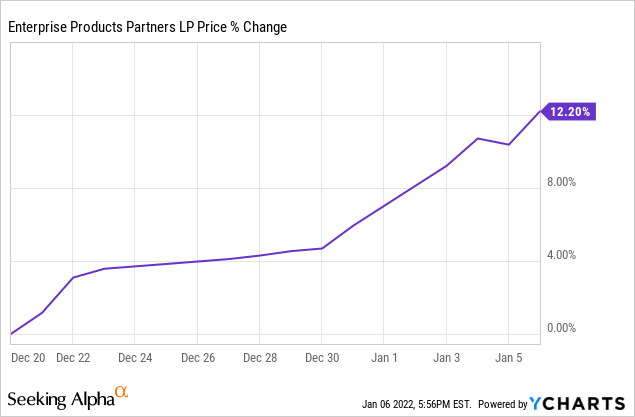Galeanu Mihai/iStock via Getty Images
Enterprise Products Partners (EPD) has been much maligned lately for its slowing distribution growth despite its strong distribution coverage and balance sheet. As a result, its unit price has been punished relative to peers who have adopted a more aggressive approach towards unitholder capital returns and allowing leverage to run higher.
For example, Magellan Midstream Partners (MMP) trades at a premium to EPD on both a P/DCF and EV/EBITDA basis despite EPD boasting a much stronger growth pipeline, significantly lower leverage and stronger debt maturity profile, and a significantly larger and better-diversified asset base with exposure to greener natural gas and NGLs compared to MMP’s focus on crude oil and refined products. The reason for this is simple: MMP has a significantly higher distribution payout ratio than EPD’s (~85% compared to ~60%) and is returning whatever excess cash flow it can generate (including from selling non-core assets opportunistically) to investors via buybacks, whereas EPD is only buying back a very small percentage of its units while it is investing somewhat aggressively in growth projects and has signaled that it may buy some assets in the near future.
Mr. Market is very bearish on the future outlook for the hydrocarbon energy space as a whole and in particular the midstream space due to the fact that there are rising political, regulatory, and activist related headwinds to new pipeline construction and even toward some prominent existing pipelines like the Dakota Access Pipeline. As a result, analysts and investors are rewarding midstream companies that are maximizing free cash flow and returning the free cash flow to investors while punishing those midstream businesses that are continuing to invest in growth projects and acquisitions.
That said, EPD’s management had signaled recently that the company would be accelerating its distribution growth starting potentially with its next quarterly distribution. Management delivered on that signal as it just announced a 3.3% hike for the next quarterly distribution and hinted at more to come. The rest of this article, we discuss what this means for unitholders.
#1. EPD’s New Distribution Hike Cements The Case For Double-Digit Annualized Total Returns
Despite the recent strong run in EPD’s unit price:

units remain clearly undervalued. With an 8% distribution yield after the most recent hike, EPD is already exceptionally well positioned to outperform without growth given that long-term interest rates remain stuck near historic lows and stocks have historically returned 8 to 10% per year on average. However, with management signaling the distribution growth will likely be in the low to mid-single digits on an annualized basis for the foreseeable future, the distribution plus growth valuation model implies that 11 to 13% annualized total returns are very likely from here.
As an additional margin of safety, EPD could also very likely see its enterprise value to EBITDA multiple expand moving forward given that it is currently at a steep discount to historical levels. Of course, multiple expansion is much less reliable given that it is dependent on market sentiment. However, in a yield starved environment where EPD not only provides a very safe distribution, but also a very attractive yield that happens to be growing at a rate that is close to inflation, it is not hard to imagine Mr. Market overcoming his negative prejudice towards hydrocarbons and pipelines and bidding up the unit price. If this happens, investors will be looking at mid to high teen total annualized returns from EPD units over the next five years or so.
#2. EPD’s Accelerating Distribution Growth Sends A Bullish Signal
Furthermore, with EPD increasing its distribution growth rate, management shot down the bear case that EPD’s conservative approach to its balance sheet and distribution growth rate relative to peers indicated a week outlook for the business and/or that management was going to sacrifice increasing unitholder capital returns in order to preserve dry powder for a major acquisition.
Instead, the partnership has made it clear that responsibly and sustainably increasing unitholder returns remains its number one priority. Investors looking for a reliable, lucrative, and growing source of income now have even fewer reasons to worry that EPD will fail to meet their needs.
#3. EPD’s Management Hinted That More Distribution Growth Could Be On The Way
Some investors might be disappointed that EPD did not hike its distribution by a greater amount, especially after management hinted on the Q3 earnings call that it would seek to match inflation (which has recently soared above 6% as per CPI figures):
Finally, [a priority] will be to execute buybacks on an opportunistic basis. As we have for the past several years, we plan to announce distribution growth guidance for 2022 in January… On inflation, I want to say over 90% of our revenues have some sort of escalation mechanism in there, which are benchmarked to various indices. So we feel like we have a pretty good protection from inflation…As far as how we think about the distribution, really what we’re trying to achieve is trying to keep to purchase power parity. And so we would like to come in, and with the increased inflation, have an increase in the distribution growth rate compared to what you’ve seen over the last 3 or 4 years.
Paul is certainly true that a 3.3% distribution increase does not match the latest CPI figures, it is still a meaningful acceleration from the 1.1% growth rate seen last year. In fact, the distribution growth rate tripled year-over-year. Beyond that, management hinted in its press release that it might not be done with quarterly distribution hikes in 2022, stating:
Enterprise will continue to evaluate opportunities to grow future cash distributions
In fact, if you simply go back to 2019 you will see that EPD increased its distribution every quarter, and had been doing that habitually for years. While management certainly did not promise that it would return to this practice, it has not ruled it out either it may very well end up going that route depending on how the remainder of the year goes. There is still a lot of uncertainty regarding the pace of economic reopening and inflation as well as the outcome of the 2022 midterm elections in the United States later this year. Given that management prides itself on its conservative approach and ability to continue raising the distribution each year for a long time to come while also sustaining the underlying business and sector leading balance sheet, it makes perfect sense that management would take a more conservative approach than some may have expected to this quarters distribution increase.
Investor Takeaway
EPD’s free cash flow is expected to increase by roughly 2% in 2022 while the unit count will be slightly lower thanks to very modest buybacks. As result, the current distribution increase indicates a fairly flat payout ratio for the company year-over-year which it has indicated is within its target payout range.
That said, if inflation remains strong and energy markets remain favorable, EPD could very well see its revenues (which are over 90% indexed to inflation according to management) outperform expectations. This would lead to ballooning free cash flow and the opportunity to continue raising the distribution later this year. We think this is a likely scenario and think it would provide further upside to our already bullish total return outlook for EPD units.

